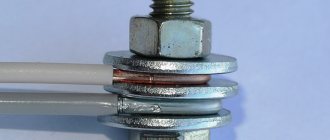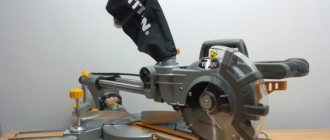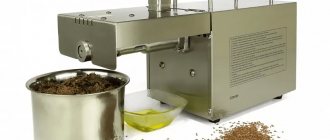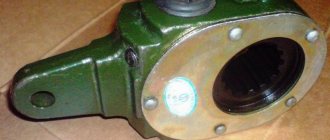What is a wood miter saw?
The miter saw has twin brothers: the pendulum saw, the electric miter box, and the angle cutter.
All these devices have a common design - a swinging arm (pendulum) with a circular saw mounted on it, a frame on which the material being cut rests, and guides along which the material is fed to the saw blade. The simplest option includes only a lever with a saw and a frame; such a tool can only saw off straight ends at right angles.
Wood miter saw
This device is used in procurement areas of production for sawing blanks of the required length from round or square rods, pipes or profiled metal products. For construction and carpentry work, a more advanced mechanism is required. The saw blade can be installed in it at an arbitrary angle in two planes. To do this, the frame is made rotary and equipped with a protractor to accurately measure the angle of rotation, and the lever with the saw attached to it can also rotate around its axis.
Workflow using a miter saw
Thanks to precision manufacturing, robust design, high rotation speed of the electric motor, the use of high-strength tool steel and modern methods of sharpening the disc, the unit provides angular and dimensional accuracy and surface quality unattainable with hand tools.
Varieties
Trimmings are divided into the following types:
- pendulum;
- combined;
- with a broach.
The basis of the pendulum device is the frame. A table is attached to it, which is based on a rotation mechanism with a ruler. This mechanism solves the problem of setting the cutting angle with its adjustment. The cutting angle can be adjusted by moving the work table relative to the surface of the base. The saw component is fixed with a handle and spring-loaded with a hinge. The pendulum moves the saw vertically.
In the combined modification, it is possible to change the cutting angle in two directions. The structure is the same as that of the pendulum crosscut, the only difference is that one more hinge has been added. In terms of changing the cutting angle in a horizontal surface, it can be changed in the horizontal direction, which is also opposite to the installed drive.
Trimming with a broach allows you to move the cutting component both along the circumference of the hinge axis and directly along the length of the cut. This is achieved due to the existing guides.
Purpose of trimmings
The main purpose of a miter saw follows from its name, and this is exactly what its inventor, Raymond DeVault, used for it. This is sawing off the ends of boards and bars exactly at right angles and exactly to size.
Sawing off the ends of boards
However, modern wood miter saws can not only cut off ends at any vertical and transverse angles. With the use of additional equipment - such as additional guides, stops, programmable broaching systems and others, they can work not only with boards and bars, but also with parts of arbitrary shape, select grooves, and form dovetail joint elements. In addition, they can be used to cut out many elements of connections from the Japanese school of carpentry, in which the assembly of wooden structures is carried out without glue and metal fasteners, only due to the precise fit of the shaped protrusions into their corresponding grooves.
Metal saw
Miter saws for metal are similar to saws for wood, but have significant design differences. Due to the greater specific gravity and greater strength of the sawn material, they are equipped with
- More powerful frames, guides and stops.
- More powerful and high-speed engines.
- Special discs made of high-strength tool steel, including diamond-coated ones.
On metal miter saws, there is also a smaller range of adjustment of the disc installation angles, eliminating bending of the workpiece and pinching of the teeth, and the broaching mechanism has a different design due to the friction properties of the metal being different from those of wood. Actually, they are less common due to the lesser need for shaped processing of the ends of rod and pipe metal products.
A professional miter saw is:
- Miter saw with broach.
- Powerful high-speed engine.
- Disc at least 250 mm in diameter.
- Wide and stable bed with durable adjustable guides.
- Sawdust removal system.
Professional miter saw with broach
It should be understood that even a professional miter saw is a highly specialized tool. It is designed for cross cutting. It will not be possible to unravel the boards on it, even if there is a broach. However, hybrid systems do not have this drawback.
Functions of hybrid models
Hybrid models are saws equipped with an additional work table with longitudinal guides, into which a removable circular saw is attached from below, and the blade goes into a groove on the table.
Hybrid miter saw model
We must be aware that this device will not be able to alternately unravel the boards and process their ends. With each change of operation, you will have to rearrange the saw and change the disk, carry out adjustments and set the initial coordinates.
This option is not acceptable for large volumes of sawing. In this case, it would be more appropriate to purchase two specialized units, each of which will be well-debugged and will be able to work with the proper accuracy and performance.
However, for an amateur craftsman who is not burdened with large production volumes and has limited funds, a hybrid model may be a good solution, especially for the first time.
How to choose the right trimmer
How to choose a miter saw so that
- Don't regret it.
- Don't overpay.
Sales consultants on the sales floor know everything about the products presented to them. However, so that the buying process does not turn into a monotonous monologue of a consultant and the suppressed silence of the buyer, who ends up taking away with him a model twice as powerful and three times more expensive than he could actually afford, the buyer needs to have a clear idea of
- why does he need a saw;
- what operations he plans to perform on it most often;
- what are the maximum dimensions of workpieces;
- what volume of work is planned per month?
Clear answers to these questions, firstly, will inspire the consultant with minimal respect, and, secondly, will allow you to narrow the range of models under consideration to reasonable limits. But even within this narrowed list, the range of prices and additional features will be great. At this stage, the buyer must decide
- does he need a laser pointer (in fact, he always needs it. The time for cutting “by eye” is over.);
- Do you need an electronic adjustment system with memory?
- Is a pulling system needed?
If a miter saw is purchased for occasional work, such as making a frame for a greenhouse or a garden gate, there is no need to splurge on a high-performance professional unit from a well-known brand with an extended base, electronic settings, controlled broaching and other improvements.
Such a saw will be needed if the buyer plans to open his own woodworking business and already has a sufficient volume of orders of medium and high complexity. In this case, a professional device will save time and quickly pay for itself.
Disc diameter and cutting parameters
Some of the most important parameters of the saw are the diameter of the blade and the cutting parameters. In a home workshop, a 250 mm disc with a seat diameter of 30 mm will be completely sufficient. Professional systems are equipped with larger diameter discs, reaching up to half a meter.
Characteristics by disc diameter and cutting parameter
The cutting length in entry-level systems usually does not exceed 150 mm. If you need to cut slab material, you will need a machine with a horizontal movement option and two guides of sufficient length. As a rule, devices of this class are equipped with a drawing system.
The maximum thickness of the material also depends on the class and power of the miter saw; for entry-level systems it is 50 mm, for professional units it reaches up to 150.
Another important parameter is the drive and transmission type. Miter saws are equipped with two types of electric motors - asynchronous or commutator. Asynchronous motors are less noisy and do not require maintenance; commutator motors have an excellent service life, but require maintenance and periodic replacement of brushes.
Torque from the engine axis to the axis of the working disk is also transmitted in two main ways - gear or belt transmission.
Geared Miter Saw
The gear drive ensures reliable operation and does not allow slipping during high loads. However, it is characterized by high noise and vibration at the resonant frequencies of the gearbox.
Belt drive is less noisy. The absence of vibration guarantees stable cutting. Needs periodic adjustment due to belt stretching and loosening.
If the saw does not turn on - typical malfunctions and repairs
A miter saw, like any mechanism operating under large dynamic loads, is susceptible to defects and malfunctions. Among the most common breakdowns of this tool are the following:
- combustion of the motor (rotor or stator), the cause of which may be the incorrect choice of cutting speed and saw blade feed, or the use of an unsuitable blade for cutting a certain material - all this leads to overload of the electric motor and its combustion;
- wear of the electric motor rotor gear or gear wheels;
- wear of brushes of an asynchronous motor;
- loose or broken drive belt.
It is better to entrust all malfunctions related to the electric motor to professionals, since repairs will require both special equipment and knowledge of the structure and operating principle of electric motors. You can independently replace the worn commutator brushes of an asynchronous motor or change the gear belt.
Additional options
Companies that produce end plates compete to provide their products with the maximum number of additional options. Some of these options are aimed at increasing safety, others at increasing productivity and developing new functions, and others at improving working conditions and ease of use.
Lighting the cutting area
Options such as:
- Lighting the cutting area.
- Speed maintenance system.
- Cutting depth limiters, allowing you to make grooves.
- Laser level indicator.
have become a de facto standard and are included in the equipment of almost every model.
Miter saw stand
A useful option at the top of the product line is a sturdy stand onto which the saw is mounted. With this addition, you don’t need to worry about mounting it on a workbench or making a separate desktop
Equipment characteristics
It is necessary to calculate all the characteristics that a cross-cutting machine for wood processing should have. They directly depend on the dimensions of the workpiece, its configuration and the requirements for the quality of facing.
First of all, you need to find out the required cutting depth and processing speed. A desktop model is suitable for home use. Large machines used in production have several cutting units and some additional functions.
However, regardless of the design features, the cross-cutting machine has the following technical parameters:
- maximum and minimum saw blade size. This parameter is responsible for the cutting depth and dimensions of future equipment
- distance from the end of the saw blade to the work table
- dimensions of the rotary block, if it is provided for by the design of the machine
- main drive motor power level
- number of revolutions and the possibility of changing them.
To connect the chip vacuum cleaner you need to know exactly the cross-section of the supply pipe. If its size is non-standard, then you can use adapters. For even more reliable fixation of the boards, you can use additional components - clamps. Their design and configuration directly depend on the dimensions of the workpiece.
What to look for when purchasing
To independently choose a miter saw, you need to formulate the same questions for yourself as for a consultant in a store.
In addition, it is important not to lose sight of the following criteria:
- Purpose of purchasing the tool. For occasional work in the home workshop, you can be satisfied with a locally produced entry-level model with a standard set of options. For professional work with large volumes, you will need a more advanced tool, equipped for those types of work that will be performed most often.
- Work safety. Make sure that the protective cover of the working disk is securely fastened and easily moved, that the power cable is sufficiently long, and that the power button latch operates reliably.
- The weight and dimensions should be within your range and ensure long-term work without fatigue.
- Ergonomics. The saw should be easy to use, fit well in the hand, and not require unnecessary movements or awkward postures when working.
The depth and width of the cut are the key characteristics that determine the list of materials available for cutting on this model and the maximum dimensions of the workpieces processed.
Main selection criteria
There are certain criteria based on which you can choose tools for cross-cutting work.
Firstly, before purchasing, you should decide in advance how often the trimmer will be used. The minimum functional set that a very specific model should have will depend on this.
In cases where it is intended to be used rarely at home, you can opt for a device with a minimum set of functions. And, on the contrary, when you plan to use this mechanism frequently, it is better to buy a professional model with a wide range of options.
Secondly, the device you purchase must be safe. Thus, the presence of a protective casing on the circular saw that covers the disk during end cutting will ensure safe working conditions.
You should estimate the total weight of the wood trim and its dimensions. If these indicators are too high, it will be difficult for the user to work with such a tool.
DIY wood miter saw
It is quite possible to make an entry-level miter saw yourself in a home workshop. To do this, it is enough to have an average level of plumbing and welding skills.
DIY wood miter saw
The following materials and equipment will be required:
- Grinder (it can be removed from the machine and used for its intended purpose).
- The steering axis of the wheel from the car, or king pin.
- Ball bearing 150 mm.
- Two shock absorbers from a truck (with faulty hydraulics, only the mechanical part is needed).
- Corner 30×30.
- Galvanized roofing sheet.
- Fasteners
- Drilling machine.
- Welding machine.
A kingpin is used as the basis of the pendulum device; it is fixed by a bearing. Ears are welded to the bearing for mounting on the frame using screws with a diameter of 6 or 8 mm. To protect the pendulum assembly from chips, a small protective box is made from sheet metal.
The broaching system is made of shock absorbers. To do this, you need to drain the oil from them and make ventilation holes; they should be protected from sawdust with a metal or nylon mesh.
The blade guard can be taken from an old circular saw or bent from tin yourself.
The resulting unit does not look as presentable as factory-produced miter saws, but has good performance characteristics: the disk rotation speed is 4500 rpm, and the cutting length is 350 mm (equal to the shock absorber stroke). You will have to put up with the high noise level of the installation, and to adjust the accuracy of the cuts, you can use a set of backing bars or come up with a more advanced design.
Characteristic versions of the mechanism
The principle of mobility of cutting units in single-saw machines is implemented by the following types of structures:
- Straightforward. The block moves on a rigid horizontal console, the height of which can be adjusted;
- Pendulum (PME). The location of the disk assembly on the suspensions allows it to move in an arc, lowering and rising;
- Balanced. The saw is located under the table, the knife is raised by pressing the pedal. Number of lifts 10 – 12 per minute;
- Stationary. The workpiece is fed to a fixed rotating wood knife.
Multi-saw installations include trimmers and slashers. On double-sided cross-cutting machines, the side and top sides of a wooden part are processed in one pass.
Pendulum type
Industrial CME (pendulum cross-cutting machine) has the following characteristic features:
- manual or pneumatic feed of the cutting unit;
- mechanized supply of parts;
- adjusting the length of the workpiece by installing stops;
- pneumatic clamp;
- electrodynamic braking.
The design of the manual feed of the DME disk works by ensuring a return to its original position under the influence of a counterweight.
The large radius of the CME installation increases the possible width of sawn timber trimming.
The suspended type of fastening makes it convenient to use the TsME machine in cutting production.
Straight stroke
Serial production of parts of a given size is carried out by a cross-cutting machine with several saw units. The distance between the disks on the wood corresponds to the required size. The lumber is pushed along a bed with rollers onto saws that cut it to size. In one shift, machines of this type process several dozen cubes of wood.
Cross-cutting machine with two saw carriages
Productivity and the accuracy of the angle between the edges of the timber are increased on double-sided equipment for trimming wood.











